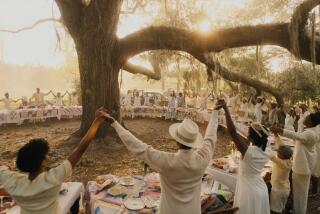Review: Flashes of lightning in Trisha Brown’s ‘Astral Converted’
The Sunset Canyon Amphitheatre, at the northwest corner of the UCLA campus, is not exactly the wilds. The bleachers overlook a recreation center’s grassy knoll and a swimming pool in the distance. Still, the amphitheater is hidden away and, thanks to UCLA’s parking militia, mildly inaccessible to the public. If that touch of trouble and remove helped make Sunset Canyon an enchanted, although challenging, venue Thursday night for Trisha Brown’s “Astral Converted,” it also helped remind us just how radically times have changed over the last two decades.
“Astral Converted” was revived by UCLA’s Center for the Art of Performance as an extravagant launch of its weekend retrospective of the Trisha Brown Dance Company. The piece originally was commissioned by the National Gallery in Washington, D.C., as part of a major Robert Rauschenberg exhibition in 1991 and presented on the museum’s steps, overlooking the National Mall.
Rauschenberg designed stunning silvery costumes for the dancers and eight space-age towers of different sizes to hold 50 automobile headlights as well as loudspeakers. The artist had just returned from Moscow, and this was our government’s enlightened way of acknowledging the artist’s ability to help the progress of perestroika and world peace through culture. The gesture was also meant as a glorious gift for the public.
PHOTOS: Scenes from Trisha Brown’s “Astral Converted”
Such gifts are, of course, no longer the business of a divided Washington (just witness the meanness of spirit surrounding the controversy over the commission of Frank Gehry’s luminous Dwight D. Eisenhower monument on the Mall). Is it any wonder that “Astral Converted,” intended for a spectacular urban setting, now seems appropriate concealed in Sunset Canyon?
No matter, the work happened to look gorgeous in the dark. Electronic sensors, triggered by the dancers’ movements, switched on and off the towers’ headlights, creating indeterminate lighting, like lightning strikes in the forest. John Cage was commissioned to write the music, and his “Eight,” for eight wind players, was meant to play off the sounds of the street and the skies. It still did — an alluring complement to the fast cars hurtling down nearby Sunset and helicopters above.
The elements, though, were a problem. The performance was delayed half an hour to wipe down slippery condensation on the stage floor. But the 50-minute piece had to be ended a little more than halfway through when the stage became dangerously wet again.
That was a pity for anyone who chose, as an attendant recommended, the $18 all-day option in the parking structure (more than the $15 cost of a ticket for the show). It was a further pity because “Astral Converted” is so rarely mounted. But for 34 minutes there was magic in the chilly night air, and that is also something very rare. Plus, the evening served as but prelude to a full Trisha Brown weekend that includes formal dance programs in Royce Hall as well as site-specific pieces at the Broad Art Center, Hammer Museum and the Getty Center.
FULL COVERAGE: 2013 Spring arts preview
Typical of Brown, the movement in “Astral Converted,” is fluidly ever-changing and operates on many levels. Every moment is a moment for something new.
The nine dancers lie on the ground, create classical friezes, partner every which way. They can be very still, stir to life gradually or operate in constant motion. Arms extend with classical grace, then become spastic. Steps are synchronized, and they are not, sometimes in the same phrase.
A brilliant solo danced by Nicholas Strafaccia offered some of all of the above. There was a beguiling bit for dancers with brooms. Next time the piece is performed outdoors, the company may consider modifying that for mops.
More suitable for this recreation center, however, were Brown’s efforts in challenging the physical capacity of her dancers, and this abbreviated “Astral Converted” lasted just long enough to include flips and other delightful gymnastic movement.
No matter what their movement, though, the outstanding dancers remained, in their shiny unitards, as entrancing as aquatic exotics. And that was an appropriate, if coincidental, reminder of UCLA’s own history of combining recreation with dance. Cage’s first musical innovation, 75 years ago, was the invention of the water gong for an aquatic ballet presented in the nearby UCLA swimming pool.
But most of all, “Astral Converted” remains a reminder of what happens when America sets out to publicly celebrate some of its greatest artists, as it did in 1991 with Brown, Rauschenberg and Cage. I hope other presenters find the funds and motivation to keep this great work alive — and, in the future, in its full 50-minute glory.
Trisha Brown Retrospective
Where and when: “Roof Piece” at Getty Center, 1 and 3 p.m. Saturday
Where and when: Performance at Royce Hall, 2 p.m. Sunday
Information: https://cap.ucla.edu/tbdc
MORE
INTERACTIVE: Christopher Hawthorne’s On the Boulevards
Depictions of violence in theater and more
PHOTOS: Arts and culture in pictures
More to Read
The biggest entertainment stories
Get our big stories about Hollywood, film, television, music, arts, culture and more right in your inbox as soon as they publish.
You may occasionally receive promotional content from the Los Angeles Times.







